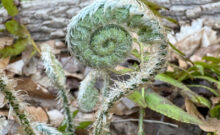5 Strategies for Softening and Deep Restoration
When an eastern chipmunk drops into hibernation, their heart rate drops from an average of 350 beats per minute to 15 little thumps, just enough to sustain life until refueling. All energy must be conserved; this is their work of winter. Any tension, constriction, or bracing would be an unnecessary energy expenditure–relaxation equates to survival.
How much energy do we expend with clinching our jaw, tightening our shoulders, or holding our hands in a fist (I used to do this at night when I slept)? These subtle muscular moves can happen without us even being aware. Scan your body now. Are you holding or bracing yourself anywhere?
Back to the chipmunk all curled up and cozy in their burrow… Their bodies are soft and relaxed, with zero effort—they can’t afford to waste energy on anything but maintaining vital functioning. This little creature inspired me to lead hibernating animal meditations with young people for the past couple of weeks. Slowing the breath and deeply relaxing the body takes on a new meaning when trying to mimic a hibernating animal.
Softening, softening, and softening more. From head to toe. This is incredibly restorative and a necessary wintering practice. To soften from all the doings from the previous year and be ready to create again when spring emerges.
Sometimes, we have been bracing or clinging for so long without being aware—that it is hard to soften. But take heart: there is even a transition time within the body of hibernating animals to help them ease into this winter slumber or great softening.
Below are simple strategies to support you in softening into the deep restoration of winter. As we soften the body—our mind, emotions, and spirit follow. What is being held within the tense muscle or being hidden by the constriction within the body—waiting to be witnessed, integrated, or released? In winter, we create space to be with what we might turn away from during the busyness of the rest of the year. This is a practice of self-compassion.
FIVE STRATEGIES TO SOFTEN FOR DEEP RESTORATION
- Take an Epsom salt bath (2 cups), and invite softness to your muscles from head to toe by simply sending your breath and intention to soften. Focusing one area at a time–the muscles in your face, shoulders, arms, hands, back, core, thighs, calves, feet.
- Progressive Muscle Relaxation: The title of this practice says it all. Start with a muscle group or hands—with a slow, deep inhalation, tighten/clinch that part of your body to the level of shaking for a slow count of 5, as you exhale, quickly release the constriction in that muscle. Relax, soften, and feel this relaxation for 10 seconds before moving to the next muscle group. Resource for practice details.
- Try restorative or yin yoga (very different from power or hot yoga). This aligns with the energy of winter.
- “Leave the battlefield.” Confrontation and defensiveness expend a lot of energy and cause our muscles to tense. Before expending this energy, is it truly worth this level of investment? As you are softening and doing the work of winter, is it possible to diffuse the situation or step away?
- Get a massage. Partner with the massage therapist—relax and send your breath into each muscle they are working on.
Blessing as we join together to soften our bodies and hearts as we continue to winter.
image: Breck Kent






